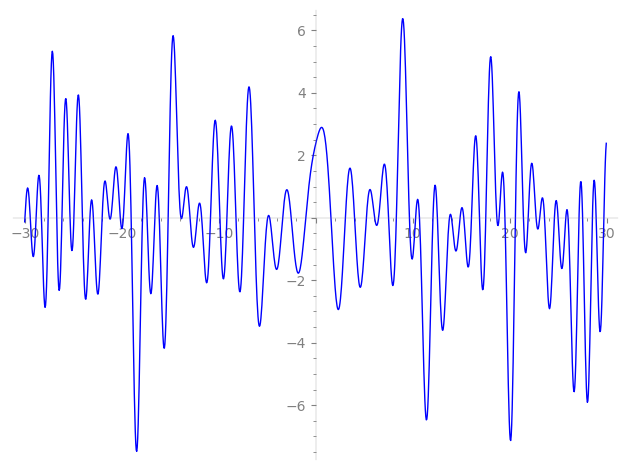| L(s) = 1 | + (0.885 − 0.885i)2-s + 0.430i·4-s + (0.684 − 2.12i)5-s + (−0.707 − 0.707i)7-s + (2.15 + 2.15i)8-s + (−1.28 − 2.49i)10-s − 0.102i·11-s + (−0.320 + 0.320i)13-s − 1.25·14-s + 2.95·16-s + (4.37 − 4.37i)17-s − 6.18i·19-s + (0.915 + 0.294i)20-s + (−0.0910 − 0.0910i)22-s + (1.19 + 1.19i)23-s + ⋯ |
| L(s) = 1 | + (0.626 − 0.626i)2-s + 0.215i·4-s + (0.305 − 0.952i)5-s + (−0.267 − 0.267i)7-s + (0.761 + 0.761i)8-s + (−0.404 − 0.788i)10-s − 0.0309i·11-s + (−0.0889 + 0.0889i)13-s − 0.334·14-s + 0.738·16-s + (1.06 − 1.06i)17-s − 1.41i·19-s + (0.204 + 0.0657i)20-s + (−0.0194 − 0.0194i)22-s + (0.250 + 0.250i)23-s + ⋯ |
\[\begin{aligned}\Lambda(s)=\mathstrut & 945 ^{s/2} \, \Gamma_{\C}(s) \, L(s)\cr =\mathstrut & (0.240 + 0.970i)\, \overline{\Lambda}(2-s) \end{aligned}\]
\[\begin{aligned}\Lambda(s)=\mathstrut & 945 ^{s/2} \, \Gamma_{\C}(s+1/2) \, L(s)\cr =\mathstrut & (0.240 + 0.970i)\, \overline{\Lambda}(1-s) \end{aligned}\]
Particular Values
| \(L(1)\) |
\(\approx\) |
\(1.86896 - 1.46272i\) |
| \(L(\frac12)\) |
\(\approx\) |
\(1.86896 - 1.46272i\) |
| \(L(\frac{3}{2})\) |
|
not available |
| \(L(1)\) |
|
not available |
\(L(s) = \displaystyle \prod_{p} F_p(p^{-s})^{-1} \)
| $p$ | $F_p(T)$ |
|---|
| bad | 3 | \( 1 \) |
| 5 | \( 1 + (-0.684 + 2.12i)T \) |
| 7 | \( 1 + (0.707 + 0.707i)T \) |
| good | 2 | \( 1 + (-0.885 + 0.885i)T - 2iT^{2} \) |
| 11 | \( 1 + 0.102iT - 11T^{2} \) |
| 13 | \( 1 + (0.320 - 0.320i)T - 13iT^{2} \) |
| 17 | \( 1 + (-4.37 + 4.37i)T - 17iT^{2} \) |
| 19 | \( 1 + 6.18iT - 19T^{2} \) |
| 23 | \( 1 + (-1.19 - 1.19i)T + 23iT^{2} \) |
| 29 | \( 1 - 6.40T + 29T^{2} \) |
| 31 | \( 1 - 6.61T + 31T^{2} \) |
| 37 | \( 1 + (3.33 + 3.33i)T + 37iT^{2} \) |
| 41 | \( 1 - 6.60iT - 41T^{2} \) |
| 43 | \( 1 + (2.74 - 2.74i)T - 43iT^{2} \) |
| 47 | \( 1 + (-1.77 + 1.77i)T - 47iT^{2} \) |
| 53 | \( 1 + (2.88 + 2.88i)T + 53iT^{2} \) |
| 59 | \( 1 + 12.8T + 59T^{2} \) |
| 61 | \( 1 + 3.25T + 61T^{2} \) |
| 67 | \( 1 + (1.55 + 1.55i)T + 67iT^{2} \) |
| 71 | \( 1 - 3.88iT - 71T^{2} \) |
| 73 | \( 1 + (-9.24 + 9.24i)T - 73iT^{2} \) |
| 79 | \( 1 + 2.10iT - 79T^{2} \) |
| 83 | \( 1 + (-8.52 - 8.52i)T + 83iT^{2} \) |
| 89 | \( 1 - 12.6T + 89T^{2} \) |
| 97 | \( 1 + (10.4 + 10.4i)T + 97iT^{2} \) |
| show more | |
| show less | |
\(L(s) = \displaystyle\prod_p \ \prod_{j=1}^{2} (1 - \alpha_{j,p}\, p^{-s})^{-1}\)
Imaginary part of the first few zeros on the critical line
−9.875614278901702727146493129107, −9.153395711766112424264784107713, −8.220574438531316921710476482245, −7.43285602083559270740985451235, −6.32574175550191083300220515121, −4.95317686221612855518284862638, −4.75090042706916596436140131643, −3.41021852191267260542487523586, −2.52835709583468890917683692952, −1.02769569413763797266878605592,
1.57102654195378158516399409209, 3.05551339708698419052781890487, 4.00472701860206307134693624492, 5.21958272520217251748881260568, 6.07462177424837157893131908519, 6.47991116573788491606557625077, 7.50679190056572830574556501359, 8.310540799370700521758459738611, 9.656768846953831429428616069767, 10.29514330238665465938638201371

